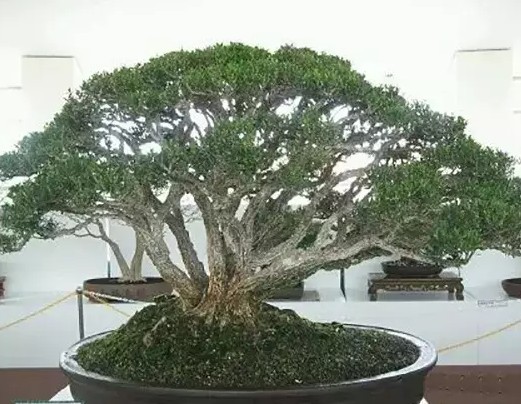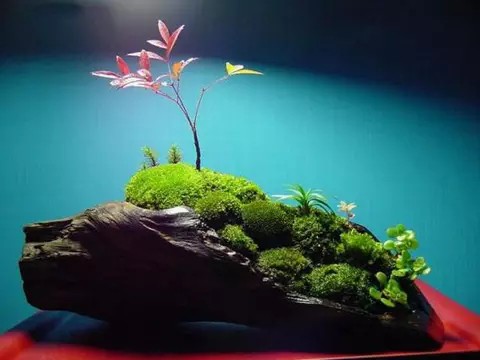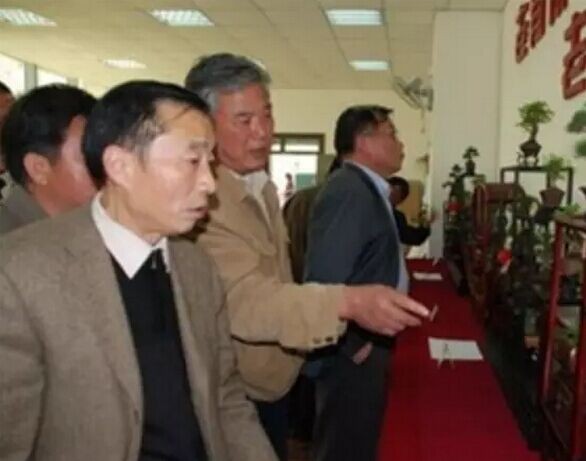Winter management of tree stump bonsai
Nowadays, when the weather turns cold, many flower bonsai begin to enter the house one after another and enter the winter management stage. we have seen many articles about the management of tree stump bonsai in spring, summer and autumn, but the winter management of tree stump bonsai is often ignored by people. often to the next spring, when everything recovers, some bonsai do not sprout for a long time, gently break the twigs, and have already dried up. At this time, I found that these tree stumps bonsai have died quietly in winter, and then want to save it, there is no way to save it, it is distressing. Therefore, the winter management of tree stump bonsai must not be taken lightly. Here are some problems that should be paid attention to in the management of bonsai in winter.

First, the time of entering and leaving the room
After "Frosts Descent", the climate became cold, plants began to shed leaves, nutrients began to transfer and accumulate into plants, and plants entered a dormant state to welcome the advent of severe winter. As a prelude to the management of tree stump bonsai in winter, we should first distinguish between those who need to survive the winter indoors and those who spend the winter outdoors, and enter the house as late as possible for the southern tree species that survive the winter indoors. It is necessary to let the trees go through a long period of low temperature adaptation process, that is, the so-called "autumn does not enter". This can not only make the trees gradually adapt to the long and severe winter environment, but also avoid the indoor temperature too high to produce new shoots. It consumes nutrition, reduces cold resistance, and can kill parasite eggs on trees in a low temperature environment. For the specific entry time, there is no uniform standard for different latitudes. During this period of time before entering the room, it is necessary to pay close attention to the local weather forecast and focus on preventing frost. When the temperature drops to 0 ℃, it is not necessary to enter the room immediately. It is just necessary to cover plastic film and other mulch at night to prevent the severe frost from hitting the branches and leaves directly. The temperature is lower and the problem is not serious. It is very necessary to ensure that the training period is about 20 days at about 0-5 ℃. Affected by the trend of global warming, it is not too late for "Lesser Snow" to enter the room before and after entering the room, and it is not too late to close the doors and windows immediately after entering the house. It is necessary to gradually shorten the window opening time so that plants can gradually adapt to the climate and environment.
After the severe winter is over, when to leave the room is also most important. We have to say that we often find a strange phenomenon. Many bonsai are good all winter. As soon as they move out in spring, they die immediately. This is what people often say, "it is easier to spend winter than spring." as we all know, plant physiology and people have a lot in common. People stay in a warm environment for a long time and suddenly go out. Will be very uncomfortable, plants are the same, in the whole winter in a relatively closed environment for a long time, coupled with early germination, internal energy consumption is serious, quite weak, the ability to adapt to the external environment is greatly reduced, suddenly moved out of the room, in case of spring cold, almost certainly die. Therefore, the correct approach is to gradually increase the number of window ventilation, prolong the ventilation time, and postpone the time of leaving the room as far as possible, the purpose is also to let the plants go through a process of gradually adapting to the environment, which is the so-called "spring does not come out". Therefore, after the severe winter, it is warm and cold, and the weather is very unstable, so we can not move the bonsai outdoors early. We should make the bonsai gradually adapt to the climate change in early spring, and then leave the room after the weather is relatively stable. The time to leave the room sooner or later, there are differences in different areas, as long as you master one, that is, there is no more frost, it is appropriate for the Huang-Huai area to leave the room before and after "Grain Rain."
Second, indoor temperature
In the indoor bonsai overwintering, how high the indoor temperature is also a key issue of bonsai winter management. Many people have a misunderstanding that the higher the indoor temperature, the better, but they do not realize that the indoor temperature varies greatly due to different tree species and training purposes. Broad-leaved evergreen is mostly medium-high temperature tree species, the winter work is temperature and humidity management, room temperature can be appropriately higher to ensure the normal growth in winter. The most taboo is that the temperature goes up and down, especially at night; for example, banyan, Fujian tea and June snow will fall old leaves and replace new leaves in late winter and early spring, so that they should not hurt the cold or lack of water, so that they can be renewed; for bonsai such as oranges, rhododendrons and cyclamen that need to enjoy flowers during the Spring Festival, they can be heated to more than 20 ℃ around the 20th of the 12th lunar month to ensure the need for flower viewing during the Spring Festival. Deciduous tree species are cold-tolerant trees with deciduous leaves in winter and need to be fully dormant. They can survive the winter safely in the outdoor leeward and sunny place. It is better to bury the trees in the ground with pots if possible. For this kind of stump, many people do not have enough understanding of the harm caused by excessive temperature. Most of the houses in the north have heating or other warming facilities, which often break the normal dormancy of plants because the temperature is too high. Sprout ahead of time in an environment with insufficient light and poor ventilation, not to mention that these long and thin buds cannot develop normally in the following spring, will shrink and die as soon as they get out of the room. Sprouting ahead of time makes the nutrients stored in the plant depleted in winter and lacks stamina. It is impossible to pull out strong branches the following spring, and even if it does not die, it is very difficult to recover its vitality. This is an important reason why many bonsai are not flourishing all the year round. Even if it is put indoors, it must be kept at a low temperature, so that it can not germinate ahead of time, generally no more than 5 ℃, to ensure that the plant body accumulates sufficient internal energy, ready to start, and draw out robust branches in the coming year.
Keep warm and guard against cold
Northern deciduous tree species and pine and cypress bonsai suitable for outdoor wintering can not be done across the board, but also need to be treated differently according to the cold resistance of tree species, placement location, depth of pots and other specific conditions. For example, honeysuckle, ginkgo and other tree species can survive the winter safely at a low temperature of-40 ℃ without any cold protection measures. for deep-pot tree stump bonsai placed on the land, especially some tree stump bonsai that have been secretly rooted, the ability of cold resistance can be greatly improved by using these stealthily rooting, do not break the stolen rooting, do not move the position of the basin, and can safely survive the winter in place without any special protection. For those shallow pot tree stumps and elevated tree stump bonsai, especially those placed on the roof platform, regardless of the size and depth of the basin, cold protection measures must be taken to protect them. The lesson in this respect is profound. Just take Xuchang as an example. In the winter of 2004, the weather was unusually cold. There were dozens of fine pomegranate piles frozen to death, and the economic loss reached hundreds of thousands of yuan. It was too late to regret. These frozen to death stumps, without exception, are bonsai raised on the roof platform, the main reason is that above the platform, the wind is strong and dry, the temperature is extremely low, and most bonsai pots are shallow and easy to freeze through, especially fruit tree bonsai, a large number of fruits, the nutrients produced by photosynthesis are transported to the fruit, the nutrient consumption of the tree is serious, the concentration of tree sap is reduced, and the freezing point of tree sap is increased. It greatly reduces the cold resistance of trees. Therefore, for these tree stumps bonsai overwintering, can not take a fluke mentality, take it lightly, we must take precautions. In fact, the solution is very simple, according to different conditions can choose to cultivate soil, dig ditches, shelter, simple greenhouse and other methods. Conditional can go to the basin or even the basin more concentrated buried in the land, seal the soil slightly higher than the original soil surface, watered once, covered with straw and other things, the whole winter no longer need any special care, you can safely survive the winter. For those without conditions, it is all the more necessary to find ways to create safe conditions for the bonsai to survive the winter, which can be covered with sawdust and slag after relative concentration, and can also build a simple greenhouse for large basins that are not easy to move. can also be wrapped on the spot broken quilt covers, cotton and other warm things, coat large plastic bags.
IV. Water and fertilizer management
Watering is a very important problem in the winter management of bonsai, which can not be underestimated. Watering in winter is not as daily as in summer, which is relatively easy. Because of this, it is easy to forget watering. For bonsai in greenhouse, it is more concentrated and regular observation, generally, there will not be any mistakes. As for the bonsai that is scattered indoors, especially in places that are not easy to be found, such as in the corner of the house or under the bed, bonsai are more likely to be ignored and often dry up because they forget to water them. Experienced people say that bonsai plants die in winter, nine times out of ten, they forget to water and die of drought, which should be taken seriously. Therefore, it should be checked regularly to replenish water in time. Bonsai in winter is in dormant period, plant metabolism is slow, need less water, so basin soil should be properly dried to prevent stagnant water rotting roots or sprouting ahead of time, but also can maintain a higher concentration of cell fluid in the tree to enhance cold resistance. Generally do not apply fertilizer in winter, but for those who no longer turn the basin in the following year, you can apply solid organic fertilizer around the basin wall in winter, and pay attention not to hurt the root system as far as possible.
5. Pruning and shape preservation
Winter pruning is an important measure to maintain tree shape, renew and rejuvenate. Many articles have elaborated on this issue. There is no need to elaborate here. What needs to be reminded is that there are differences in different pruning purposes and stump shaping degrees. For molded trees, for the purpose of type preservation, pruning to remove the weak and preserve the strong, once in place, but winter pruning directly affects the trend of branching in the coming year, as long as the pruning is close to the bud eye, distinguish between internal and external buds. Usually leave sprouts. Also pay attention to shortening and retrenchment, and renew and reinvigorate. For the stump in the billet stage, the principle of pruning is to take advantage of surplus to fill the gap and move the fruit to be empty, with the middle cutting as the main and the long as the auxiliary. Practice has proved that when the full buds are cut to the middle and upper part of the branch, these full buds can pull out the stout branches, which is more conducive to the thickening of the stumps, complete the excessive classification from the trunk to the branch receptacle as soon as possible, shorten the forming time, and carry out flat binding and bending of the trimmed branches at the same time, so as to avoid being unable to take the bend after thickening. Winter flowers are mostly embellished for festivals, such as plum, peach, spring greeting, wax plum, begonia and so on. For this kind of bonsai, measures can be taken to promote flowering according to the sensitivity of trees to temperature. Bonsai with buds are gradually warmed up one month before the Spring Festival to break dormancy early so as to blossom and sprout. After blooming, this kind of bonsai is weak and extremely winning. after the flower fade, you should cut off the residual flowers in time and trim them to promote the germination of new shoots and form more flower branches of the second year, and avoid re-cutting in the dormant period. After germination, thin fertilizer is applied frequently to make it recover slowly. There is also a point, for Tamarix, sparrow plum, pyracantha and other tree species that are easy to sprout down and retreat branches, when pruning in winter, they should stay long properly. For trees that bloom in early spring, the flower buds on the branches were differentiated last year, so they cannot be cut short in spring, and the correct pruning time should be placed after the flower fade. If pomegranate and crape myrtle blossom on the branches of the same year, they should be re-cut in the dormant period, which can promote the shade to send new branches and increase flowering.
(note: this article has been published in the first issue of China Flower Bonsai magazine in 2009)
Time: 2019-06-04 Click:
- Prev

The method of "spot moss" of landscape bonsai
The mention of moss bonsai can not help but remind us of Japanese-style horticultural landscape, lovely shape, green bonsai by people's imagination to add different themes, a small container is a miniature small world. The advantage of making moss bonsai is to cultivate our carefulness and patience.
- Next

Development Prospect and Characteristics of Miniature Bonsai in the 21st Century
Miniature bonsai can beautify and improve the ecological environment, enhance the artistic cultivation and cultural heritage of residence; besides, mini-bonsai can make bonsai such as viewing leaves, flowers, roots and fruits enter thousands of households and ordinary people's homes (inheriting bonsai culture).
Related
- Fuxing push coffee new agricultural production and marketing class: lack of small-scale processing plants
- Jujube rice field leisure farm deep ploughing Yilan for five years to create a space for organic food and play
- Nongyu Farm-A trial of organic papaya for brave women with advanced technology
- Four points for attention in the prevention and control of diseases and insect pests of edible fungi
- How to add nutrient solution to Edible Fungi
- Is there any good way to control edible fungus mites?
- Open Inoculation Technology of Edible Fungi
- Is there any clever way to use fertilizer for edible fungus in winter?
- What agents are used to kill the pathogens of edible fungi in the mushroom shed?
- Rapid drying of Edible Fungi

